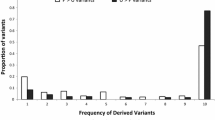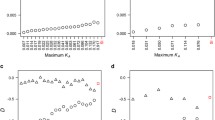Abstract
Recent work has shown that Drosophila melanogaster genes with fast-evolving nonsynonymous sites have lower codon usage bias. This pattern has been attributed to interference between positive selection at nonsynonymous sites and weak selection on codon usage. Here we have looked for this correlation in a much larger and less biased dataset, comprising 630 gene pairs from D. melanogaster and D. yakuba. We confirmed that there is a negative correlation between the rate of nonsynonymous substitutions (dN) and codon bias in D. melanogaster. We then tested the interference hypothesis and other alternative explanations, including one involving gene expression. We found that dN indeed correlates with the level of gene expression. Given that gene expression is a strong determinant of codon bias, the relationship between dN and codon bias might be a by-product of gene expression. However, our tests show that none of the hypotheses we consider seem to explain the data fully.



Similar content being viewed by others
References
H Akashi (1994) ArticleTitleSynonymous codon usage in Drosophila melanogaster: Natural selection and translational accuracy Genetics 136 927–935 Occurrence Handle1:CAS:528:DyaK2MXpsFaq Occurrence Handle8005445
H Akashi (1996) ArticleTitleMolecular evolution between Drosophila melanogaster and D. simulans: Reduced codon bias, faster rates of amino acid substitution, and larger proteins in D. melanogaster Genetics 144 1297–1307
H Akashi (1999) ArticleTitleWithin and between species DNA sequence variation and the “footprint” of natural selection Gene 238 39–51
H Akashi (2001) ArticleTitleGene expression and molecular evolution Curr Opin Genet Dev 11 660–666
H Akashi (2003) ArticleTitleTranslational selection and yeast proteome evolution Genetics 164 1291–1303
SF Altschul TL Madden AA Schaffer J Zhang Z Zhang W Miller DJ Lipman (1997) ArticleTitleGapped BLAST and PSI-BLAST: A new generation of protein database search programs Nucleic Acids Res 25 3389–3402 Occurrence Handle1:CAS:528:DyaK2sXlvFyhu7w%3D Occurrence Handle9254694
M Ashburner (1989) Drosophila: A laboratory handbook and manual Cold Spring Harbor Laboratory Press Cold Spring Harbor, NY
D Bachtrog (2003) ArticleTitleAdaptation shapes patterns of genome evolution on sexual and asexual chromosomes in Drosophila Nat Genet 34 215–219
AJ Betancourt DC Presgraves (2002) ArticleTitleLinkage limits the power of natural selection in Drosophila Proc Natl Acad Sci USA 99 13616–13620
N Bierne A Eyre-Walker (2003) ArticleTitleThe problem of counting sites in the estimation of the synonymous and nonsynonymous substitution rates: Implications for the correlation between the synonymous substitution rate and codon usage bias Genetics 165 1587–1597
N Bierne A Eyre-Walker (2004) ArticleTitleThe genomic rate of adaptive amino-acid substitution in Drosophila Mol Biol Evol 21 1350–1360
B Charlesworth (1994) ArticleTitleThe effect of background selection against deleterious mutations on weakly selected, linked variants Genet Res 63 213–227
JM Comeron M Kreitman (1998) ArticleTitleThe correlation between synonymous and nonsynonymous substitutions in Drosophila: Mutation, selection or relaxed constraints? Genetics 150 767–775
T Domazet-Loso D Tautz (2003) ArticleTitleAn evolutionary analysis of orphan genes in Drosophila Genome Res 13 2213–2219
KA Dunn JP Bielawski Z Yang (2001) ArticleTitleSubstitution rates in Drosophila nuclear genes: Implications for translational selection Genetics 157 295–305
L Duret (2002) ArticleTitleEvolution of synonymous codon usage in metazoans Curr Opin Genet Dev 12 640–649
L Duret D Mouchiroud (2000) ArticleTitleDeterminants of substitution rates in mammalian genes: Expression pattern affects selection intensity but not mutation rate Mol Biol Evol 17 68–74 Occurrence Handle1:CAS:528:DC%2BD3cXotF2quw%3D%3D Occurrence Handle10666707
L Duret D Mouchiroud (1999) ArticleTitleExpression pattern and, surprisingly, gene length shape codon usage in Caenorhabditis, Drosophila, and Arabidopsis Proc Natl Acad Sci USA 96 4482–4487 Occurrence Handle10.1073/pnas.96.8.4482 Occurrence Handle1:CAS:528:DyaK1MXjs1yls7Y%3D Occurrence Handle10200288
JC Fay GJ Wyckoff CI Wu (2002) ArticleTitleTesting the neutral theory of molecular evolution with genomic data from Drosophila Nature 415 1024–1026
I Gordo B Charlesworth (2001) ArticleTitleGenetic linkage and molecular evolution Curr Biol 11 R684–R686
LD Hurst (2002) ArticleTitleThe Ka/Ks ratio: Diagnosing the form of sequence evolution Trends Genet 18 486
T Ikemura (1985) ArticleTitleCodon usage and tRNA content in unicellular and multicellular organisms Mol Biol Evol 2 13–34 Occurrence Handle1:CAS:528:DyaL2MXhvFyksbk%3D Occurrence Handle3916708
Y Kim (2004) ArticleTitleEffect of strong directional selection on weakly selected mutations at linked sites: Implication for synonymous codon usage Mol Biol Evol 21 286–294
RM Kliman J Hey (1993) ArticleTitleReduced natural selection associated with low recombination in Drosophila melanogaster Mol Biol Evol 10 1239–1258
RM Kliman J Hey (2003) ArticleTitleHill-Robertson interference in Drosophila melanogaster: Reply to Marais, Mouchiroud and Duret Genet Res 81 89–90
F Lemeunier M Ashburner (1976) ArticleTitleRelationships in the melanogaster species subgroup of the genus Drosophila (Sophophora). II. Phylogenetic relationships between six species based upon polytene banding sequences Proc R Soc Lond B 193 257–294
G Marais B Charlesworth (2003) ArticleTitleGenome evolution: Recombination speeds up adaptive evolution Curr Biol 13 R68–R70
G Marais L Duret (2001) ArticleTitleSynonymous codon usage, accuracy of translation, and gene length in Caenorhabditis elegans J Mol Evol 52 275–280
G Marais G Piganeau (2002) ArticleTitleHill-Robertson interference is a minor determinant of variations in codon bias across Drosophila melanogaster and Caenorhabditis elegans genomes Mol Biol Evol 19 1399–1406
G Marais D Mouchiroud L Duret (2001) ArticleTitleDoes recombination improve selection on codon usage? Lessons from nematode and fly complete genomes Proc Natl Acad Sci USA 98 5688–5692 Occurrence Handle10.1073/pnas.091427698 Occurrence Handle1:CAS:528:DC%2BD3MXjs1WnsLo%3D Occurrence Handle11320215
G Marais D Mouchiroud L Duret (2003) ArticleTitleNeutral effect of recombination on base composition in Drosophila Genet Res 81 79–87
GA McVean B Charlesworth (1999) ArticleTitleA population genetic model for the evolution of synonymous codon usage: patterns and predictions Genet Res 74 145–158
GA McVean B Charlesworth (2000) ArticleTitleThe effects of Hill–Robertson interference between weakly selected mutations on patterns of molecular evolution and variation Genetics 155 929–944 Occurrence Handle1:STN:280:DC%2BD3cvislKrtw%3D%3D Occurrence Handle10835411
SV Nuzhdin ML Wayne KL Harmon LM McIntyre (2004) ArticleTitleCommon pattern of evolution of gene expression level and protein sequence in Drosophila Mol Biol Evol 21 1508–1517
SP Otto P Yong (2002) ArticleTitleThe evolution of gene duplicates Adv Genet 46 451–483
C Pal B Papp LD Hurst (2001) ArticleTitleHighly expressed genes in yeast evolve slowly Genetics 158 927–931
M Parisi R Nuttall D Naiman G Bouffard J Malley J Andrews S Eastman B Oliver (2003) ArticleTitlePaucity of genes on the Drosophila X chromosome showing male-biased expression Science 299 697–700
EP Rocha A Danchin (2004) ArticleTitleAn analysis of determinants of amino acids substitution rates in bacterial proteins Mol Biol Evol 21 108–116
C Schlotterer MT Hauser A von Haeseler D Tautz (1994) ArticleTitleComparative evolutionary analysis of rDNA ITS regions in Drosophila Mol Biol Evol 11 513–522
NG Smith A Eyre-Walker (2002) ArticleTitleAdaptive protein evolution in Drosophila Nature 415 1022–1024
WJ Swanson AG Clark HM Waldrip-Dail MF Wolfner CF Aquadro (2001) ArticleTitleEvolutionary EST analysis identifies rapidly evolving male reproductive proteins in Drosophila Proc Natl Acad Sci USA 98 7375–7379
AO Urrutia LD Hurst (2003) ArticleTitleThe signature of selection mediated by expression on human genes Genome Res 13 2260–2264 Occurrence Handle10.1101/gr.641103 Occurrence Handle1:CAS:528:DC%2BD3sXotF2hsLk%3D Occurrence Handle12975314
Acknowledgments
We thank Andrea Betancourt for kindly providing her dataset to us. We are grateful to Hiroshi Akashi, Daven Presgraves, and two anonymous referees for valuable comments on our manuscript. Experimental work was supported by a Deutsche Forschungsgemeinschaft (DFG) grant to D.T. and T.D. (Ta99-17). G.M. is a European Union Marie Curie postdoctoral fellow.
Author information
Authors and Affiliations
Corresponding author
Additional information
Reviewing Editor: Dr. John Huelsenbeck
Appendix
Rights and permissions
About this article
Cite this article
Marais, G., Domazet-Lošo, T., Tautz, D. et al. Correlated Evolution of Synonymous and Nonsynonymous Sites in Drosophila. J Mol Evol 59, 771–779 (2004). https://doi.org/10.1007/s00239-004-2671-2
Received:
Accepted:
Issue Date:
DOI: https://doi.org/10.1007/s00239-004-2671-2




